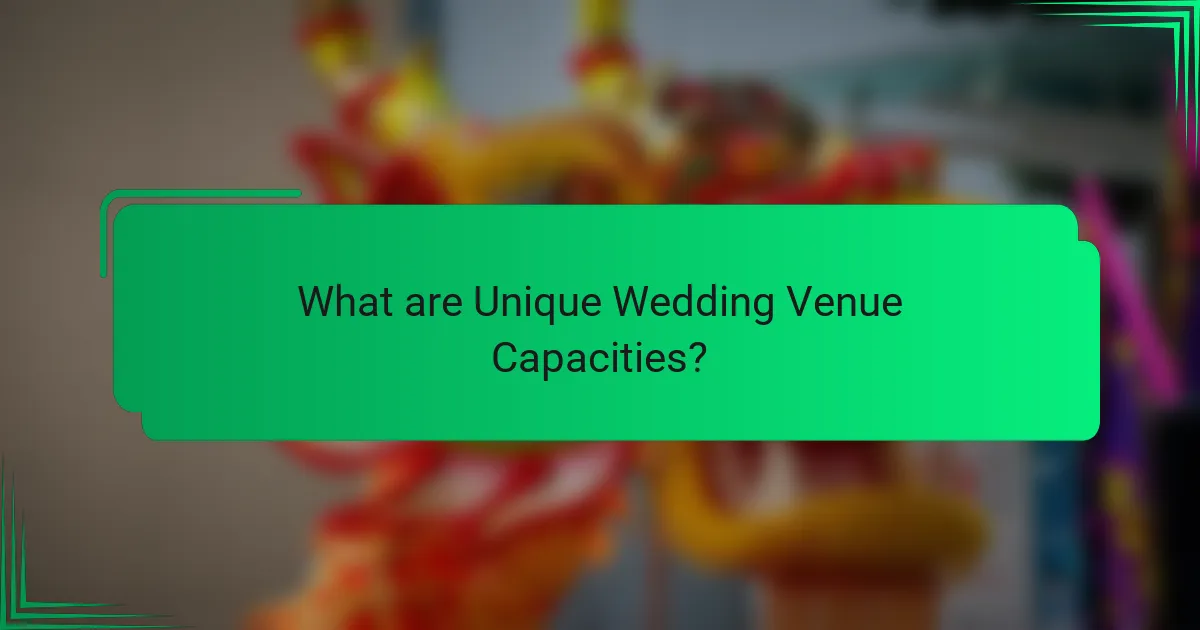Unique wedding venue capacities refer to the maximum number of guests that distinctive locations can accommodate, including barns, museums, beaches, vineyards, and historic mansions. This article provides an overview of how venue capacities vary based on layout and design, with specific examples illustrating different maximum guest counts. It emphasizes the importance of confirming capacity limits and understanding space requirements to ensure a comfortable experience for attendees. Additionally, the article offers guidance on selecting the right venue size by considering guest lists, layout flexibility, and space for activities, ensuring an optimal setting for wedding celebrations.

What are Unique Wedding Venue Capacities?
Unique wedding venue capacities refer to the maximum number of guests that can be accommodated in distinctive locations. These venues often include barns, museums, or outdoor gardens. Capacities can vary significantly based on the venue’s layout and design. For example, a converted barn may hold 150 guests, while a museum gallery might accommodate 300. Outdoor venues can vary widely, with some able to host thousands of guests. It is essential to confirm capacity limits with the venue to ensure a comfortable experience for all attendees. Many venues also provide detailed floor plans that help visualize space usage.
How do venue capacities impact wedding planning?
Venue capacities directly influence wedding planning by determining the number of guests that can be accommodated. A venue’s capacity affects the overall guest list size. Couples must choose a venue that aligns with their desired attendance. If the venue is too small, it can lead to discomfort and safety issues. Conversely, a venue that is too large may create a sparse atmosphere. Budget considerations are also impacted by venue capacity. Larger venues often come with higher rental costs. Therefore, selecting the appropriate venue capacity is crucial for a successful wedding.
What factors determine the ideal venue capacity for a wedding?
The ideal venue capacity for a wedding is determined by guest count, event style, and venue layout. Guest count refers to the number of attendees invited to the wedding. A larger guest list necessitates a bigger venue to accommodate everyone comfortably. Event style impacts capacity; a formal sit-down dinner requires more space than a casual cocktail reception. Venue layout includes the arrangement of tables, dance floor, and other elements. An open layout may allow for more guests than a venue with fixed seating. Additionally, local regulations may impose limits on venue capacity based on safety codes. Understanding these factors helps in selecting the right venue size for a successful wedding.
How can guest list size influence venue selection?
Guest list size significantly influences venue selection by determining the space required for the event. Venues must accommodate all attendees comfortably. A small guest list may allow for more intimate settings. Conversely, a larger guest list necessitates spacious venues with adequate facilities. For example, venues with capacities ranging from 50 to 200 guests cater to mid-sized gatherings. Larger venues can host events with over 500 attendees. Choosing the right venue ensures a pleasant experience for guests. Insufficient space can lead to discomfort and logistical issues. Therefore, aligning guest list size with venue capacity is crucial for event success.
Why is it important to choose the right venue size?
Choosing the right venue size is crucial for the success of an event. The venue size directly impacts guest comfort and experience. A space that is too small can lead to overcrowding and discomfort. Conversely, a venue that is too large can create a sense of emptiness and disengagement. Proper venue sizing ensures adequate space for seating, movement, and activities. It also affects logistical aspects such as catering and audio-visual arrangements. Studies show that guest satisfaction increases when the venue size is appropriate for the number of attendees. Therefore, selecting the right venue size enhances overall event enjoyment and success.
What are the consequences of choosing a venue that is too small?
Choosing a venue that is too small can lead to overcrowding and discomfort for guests. This can create an unpleasant atmosphere, making it difficult for attendees to move freely. Guests may feel cramped, which can detract from their overall experience. Additionally, a small venue may limit seating arrangements and accessibility. It can also hinder the setup of necessary equipment, such as audio-visual gear. Inadequate space can result in poor acoustics, making it hard for guests to hear speeches or music. Furthermore, fire safety regulations may be violated, posing serious risks. Overall, selecting an appropriately sized venue is crucial for a successful event.
How does an oversized venue affect the wedding experience?
An oversized venue can create a sense of disconnect during a wedding. Guests may feel lost in a large space, impacting their engagement. This can lead to a lack of intimacy, which is often desired in wedding settings. The atmosphere may feel less personal and more like an event rather than a celebration of love. Additionally, the logistics of filling a large space can complicate the event planning process. It may require more decor and seating arrangements to create a warm ambiance. Ultimately, an oversized venue can detract from the overall experience if not matched with the right guest count.

What types of unique wedding venues are available?
Unique wedding venues include barns, beaches, vineyards, and historic mansions. Barns offer rustic charm and often accommodate large gatherings. Beaches provide a scenic backdrop and a relaxed atmosphere. Vineyards create a romantic setting with beautiful landscapes and often include wine tasting options. Historic mansions add elegance and character, often featuring beautiful architecture. Unique venues can also include art galleries, museums, and botanical gardens, which offer distinct aesthetics. Each venue type caters to different themes and guest capacities, allowing couples to choose based on their vision.
How do different venue types cater to varying guest capacities?
Different venue types cater to varying guest capacities by offering distinct layouts and configurations. Banquet halls typically accommodate large groups, often seating hundreds. In contrast, intimate venues like boutique hotels or private homes cater to smaller gatherings, often hosting 20 to 50 guests. Outdoor venues, such as gardens or parks, can be flexible, allowing for larger capacities depending on space availability. Event spaces often provide customizable options, enabling planners to adjust seating arrangements based on the number of attendees. This adaptability is essential for ensuring comfort and engagement during celebrations. Each venue type’s design influences how effectively it can accommodate varying guest counts.
What are the capacity ranges for outdoor wedding venues?
Outdoor wedding venues typically accommodate between 50 to 500 guests. Smaller venues can host intimate gatherings of around 50 to 100 guests. Mid-sized venues generally cater to 100 to 300 guests. Larger outdoor venues can accommodate 300 to 500 guests or more. The specific capacity often depends on the venue’s layout and available space. Many outdoor venues also offer flexibility with seating arrangements to maximize guest capacity.
How do indoor venues differ in capacity options?
Indoor venues differ in capacity options based on their design and purpose. Some venues are designed for small gatherings, accommodating 50 to 100 guests. Others cater to larger events, hosting 200 to 500 attendees or more. Capacity is influenced by factors such as seating arrangements, stage presence, and overall layout. For example, banquet halls often provide flexible seating that can increase capacity. Conversely, theaters are limited by fixed seating. Additionally, some venues offer outdoor spaces that can expand capacity during favorable weather. Local regulations may also impact maximum occupancy limits. Understanding these differences is crucial for selecting the right venue for a wedding celebration.
What are some popular unique wedding venue options?
Popular unique wedding venue options include barns, botanical gardens, and art galleries. Barns provide rustic charm and spacious settings for large gatherings. Botanical gardens offer beautiful natural backdrops and serene environments. Art galleries present a modern aesthetic with creative displays and open spaces. These venues cater to various styles and preferences. Each option allows for customization to reflect the couple’s personality. Choosing a unique venue can enhance the wedding experience. It creates memorable moments for the couple and their guests.
How do barns and farms accommodate different guest sizes?
Barns and farms accommodate different guest sizes by offering flexible space options. Many barns have large open areas that can be adjusted for various layouts. They often include separate rooms for smaller gatherings or breakout sessions. Farms may feature outdoor spaces, such as gardens or fields, that can expand capacity. Some venues provide rental furniture to optimize seating arrangements. Additionally, barns and farms can often accommodate larger groups by utilizing tents or extensions. This adaptability allows for customized experiences based on the number of guests. Overall, these venues are designed to cater to diverse event sizes effectively.
What is the capacity potential of historic buildings for weddings?
The capacity potential of historic buildings for weddings varies widely. Many historic venues can accommodate between 50 to 300 guests. Some larger estates or converted warehouses can host up to 500 guests. The specific capacity depends on the building’s design and layout. For example, churches may have fixed seating that limits guest numbers. Ballrooms in historic hotels often have flexible seating arrangements. Regulations and safety codes also impact capacity limits. Understanding these factors is essential for couples when planning their wedding.

How can you determine the right size for your wedding venue?
To determine the right size for your wedding venue, consider your guest list size. Calculate the number of attendees you expect. This figure will guide your venue selection. Venues typically provide capacity limits. Ensure the venue can accommodate your guest count comfortably. Factor in space for dining, dancing, and other activities. A good rule of thumb is to allow 10-15 square feet per guest for dining. Additionally, consider the layout of the venue. Open spaces may require more room for movement. Review venues that offer flexibility in seating arrangements. This can enhance comfort and flow during the event.
What steps should you take to assess your venue needs?
Identify the purpose of your event. Determine the number of guests you expect. Consider the type of event and activities planned. Evaluate your budget for venue costs. Research potential venues that meet your criteria. Visit shortlisted venues to assess space and amenities. Check for accessibility and parking options. Review venue policies and restrictions.
How can you effectively estimate your guest list?
To effectively estimate your guest list, start by creating a preliminary list of potential attendees. Consider including immediate family, close friends, and significant acquaintances. Next, categorize guests into must-invite and optional categories. This helps prioritize whom to include.
Use your venue’s capacity as a guideline. Research the maximum number of guests your chosen venue can accommodate. Additionally, consider the type of event, as formal weddings may require a different approach than casual gatherings.
Review past events for insights on attendance rates. Historical data can provide a realistic expectation of how many guests will RSVP. Lastly, send out save-the-dates to gauge interest and encourage early responses. This will help refine your final guest list.
What tools can help in measuring venue space requirements?
Tools that can help in measuring venue space requirements include floor plan software, tape measures, and online calculators. Floor plan software allows users to create detailed layouts and visualize space usage. Tape measures provide accurate physical dimensions of the venue. Online calculators help estimate guest capacity based on desired layout and seating arrangements. Utilizing these tools ensures a precise understanding of space needs for events.
What are best practices for selecting the right venue capacity?
Determine the number of guests to establish venue capacity. This number should include all attendees, including the couple, family, and vendors. Consider the layout and type of event when selecting the venue size. A seated dinner requires more space than a cocktail-style reception.
Account for additional space for entertainment, dining, and dancing. A general guideline is to allow 10 square feet per person for a standing reception and 15 square feet for a seated meal.
Review local regulations for maximum occupancy limits. These regulations ensure safety and compliance with fire codes.
Conduct a site visit to visualize the space. This allows for assessment of flow and comfort for guests.
Lastly, factor in the venue’s amenities and services. Some venues provide tables, chairs, and decor that can influence the overall capacity needed.
How can you balance comfort and capacity for your guests?
To balance comfort and capacity for your guests, determine the optimal space per person. Aim for 10 to 12 square feet per guest for a comfortable setting. This allows space for seating, movement, and dining. Consider the type of event when calculating capacity. A seated dinner requires more space than a cocktail reception. Use furniture arrangements to enhance comfort. Arrange seating to promote conversation and ease of movement. Monitor guest feedback to adjust future events. Research shows that proper space allocation improves guest satisfaction significantly.
What considerations should you keep in mind for future growth?
Consider future growth by evaluating potential venue capacity needs. Anticipate changes in guest list size based on trends in wedding attendance. Analyze local demographic shifts to understand population growth in your area. Assess the likelihood of hosting larger events or multiple celebrations in a year. Consider flexible space options that can accommodate varying group sizes. Invest in scalable infrastructure that allows for easy expansion. Monitor industry trends to stay ahead of demand for unique wedding experiences. This strategic approach ensures your venue remains competitive and adaptable to market changes.
What tips can help you choose the perfect wedding venue size?
Determine your guest count first. This number will guide your venue size choice. Consider the comfort of your guests. Each guest typically requires about 10 to 12 square feet. Factor in space for tables, chairs, and a dance floor. Venues may have capacity limits; check these before deciding. Think about the layout of the venue. An open space may feel different than a divided one. Visualize the flow of the event. Ensure guests can move easily between areas. Lastly, consider your budget. Larger venues often come with higher costs.
Unique wedding venue capacities refer to the maximum number of guests that distinctive locations can accommodate, including barns, museums, and outdoor gardens. This article explores the impact of venue capacity on wedding planning, emphasizing the importance of aligning guest list size with venue selection to ensure comfort and satisfaction. It discusses various factors that determine ideal venue capacity, such as event style and layout, and highlights different venue types, including their capacity ranges and unique characteristics. Additionally, it provides practical tips for determining the right venue size and balancing comfort with capacity for a successful celebration.
